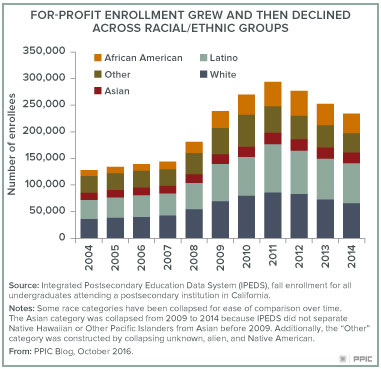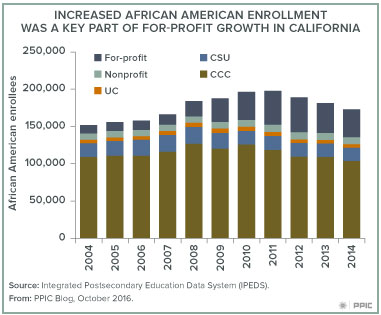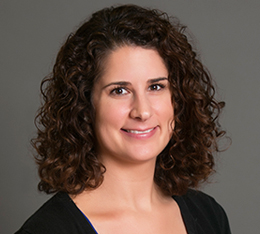After expanding rapidly for several years, enrollment in for-profit colleges has been declining since 2011. The decline in enrollment, which PPIC has noted, coincides with investigations of predatory for-profit marketing practices, restrictions on Cal Grant eligibility for some for-profit schools, and various closures, most recently ITT Tech.
 During the period of rapid growth (between 2004 and 2011), enrollment in for-profits grew across every racial/ethnic group. While white and Latino students account for more than half of enrollment, African American enrollment saw the greatest growth―total for-profit enrollment doubled, but African American enrollment more than quadrupled.
During the period of rapid growth (between 2004 and 2011), enrollment in for-profits grew across every racial/ethnic group. While white and Latino students account for more than half of enrollment, African American enrollment saw the greatest growth―total for-profit enrollment doubled, but African American enrollment more than quadrupled.
Overall African American postsecondary enrollment increased by more than 46,000 students, and three-quarters of that growth was due to increased enrollment in for-profit schools. In 2004, the statewide share of African Americans enrolled in for-profit schools (8%) was similar to the share of African American high school graduates (7%). By 2011, African Americans made up 15% of overall for-profit enrollment, compared to about 7% of high school graduates meaning they made up disproportionately high share of for-profit enrollment relative their high school graduates numbers.
Since 2011, for-profit enrollment has steadily declined. From 2011 to 2014, for-profits saw a 20% drop across all racial/ethnic groups, while total postsecondary enrollment fell by only about 4%. In the same timeframe, total African American postsecondary enrollment fell about 13%, and much of that decline was due to falling enrollment at for-profit institutions and community colleges. Even so, one in five African American students are still enrolled in for-profit institutions, compared to fewer than one in ten white, Asian, and Latino students.
 The fact that the overall African American postsecondary enrollment has dropped twice as much as this group’s high school graduation rate suggests that African American college enrollment may not be shifting from for-profits to other California institutions. If additional for-profits close, the college-going rate of African American students may continue to fall. Indeed, it may have fallen over the past year—we don’t yet have data on what has happened with enrollment since the shuttering of large for-profit institutions such as Heald, Wyotech, and ITT Tech.
The fact that the overall African American postsecondary enrollment has dropped twice as much as this group’s high school graduation rate suggests that African American college enrollment may not be shifting from for-profits to other California institutions. If additional for-profits close, the college-going rate of African American students may continue to fall. Indeed, it may have fallen over the past year—we don’t yet have data on what has happened with enrollment since the shuttering of large for-profit institutions such as Heald, Wyotech, and ITT Tech.
What can public and nonprofit colleges do to attract students who have been or would be likely to enroll in for-profits? Some community colleges are reaching out to the ITT Tech students, and several colleges are starting to adopt some of the practices many students find enticing about for-profit institutions, including online courses and more flexible course scheduling. In addition to ensuring that more Californians, and more African Americans in particular, attend college, public and nonprofit institutions could help prevent high levels of student debt, which students in for-profit colleges are more likely to accrue and default on than students at other institutions.
Read Higher Education in California: Making College Affordable
Visit the PPIC Higher Education Center



